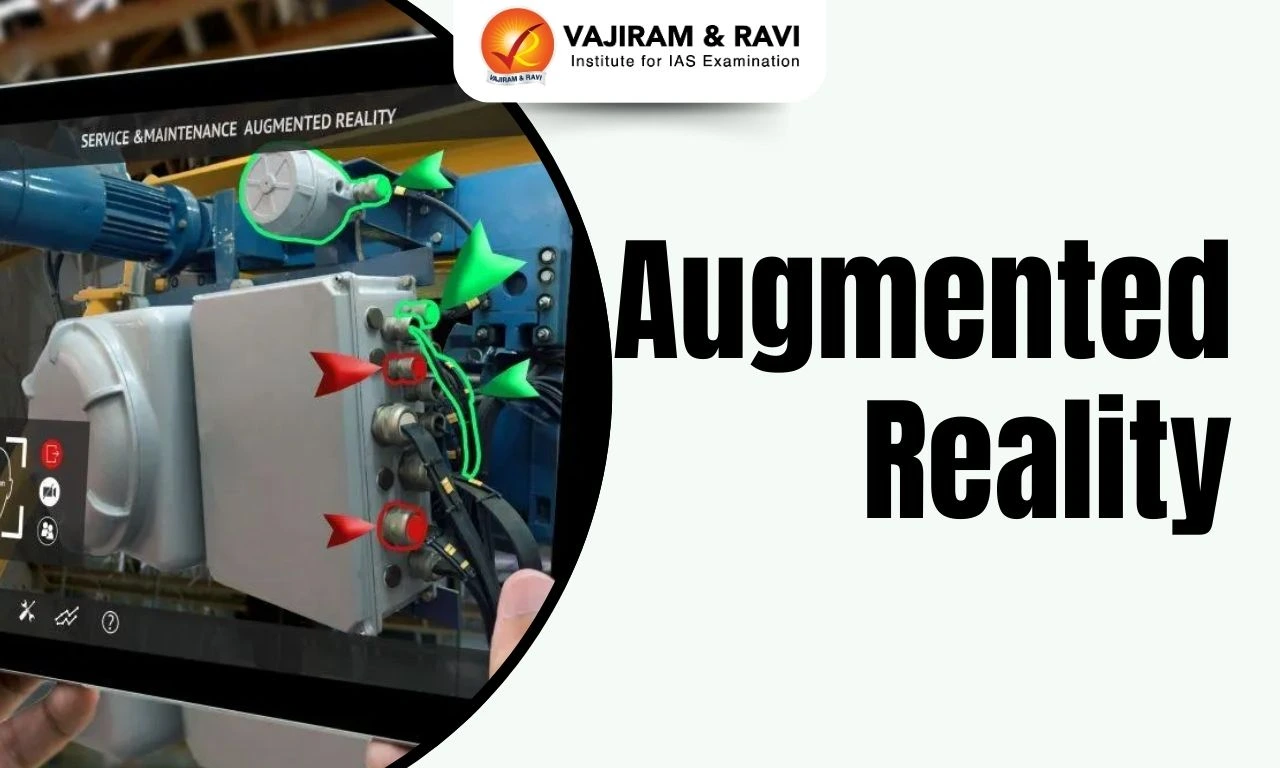Augmented Reality (AR) is the state-of-the-art technology that superimposes computer-generated elements on the physical world, improving users' perception and interaction with their surroundings. Individuals can seamlessly blend virtual content with reality by using AR-capable devices such as smartphones or AR glasses, creating a seamless and captivating experience.
The size of the global augmented reality and virtual reality market stood at US$ 28 billion in 2021 and is projected to reach US$ 250 billion by 2028. Similarly, its market size in India is expected to grow at 38.29%CAGR to US$ 14.07 billion by 2027, mostly driven by increased smartphone usage and widespread internet connectivity.
Augmented Reality and Its Working
Augmented Reality (AR) is a real-world augmented experience in which simulated digital imagery is superimposed or mixed with the real world as seen through a camera or display, such as a smartphone and heads-up display (HUD).
- History: AR was invented by Morton Heilig in 1957, followed by Ivan Sutherland who developed the first head-mounted display system in 1968.
- Since then, the technology has come a long way, touching upon almost every industry from NASA leveraging Augmented Reality to assist in providing better navigation during test flights to Google developing AR glasses for immersive experiences.
- Components:
- Software: Artificial intelligence, AR software, and Processing.
- Hardware: Processor, display, sensors, and input devices, AR-capable devices such as smartphones or AR glasses.
- Working:
- AR is powered by a combination of hardware, software, and sensors. The process begins with a device equipped with a camera and sensors, such as a smartphone or AR headset.
- The camera records the user's perspective of the physical world, while the sensors record information about the user's position and orientation.
- The software analyses camera input and sensor data to determine the user's location and where virtual objects should be placed in the real world.
- The digital content is then rendered and overlayed onto the live camera feed, aligning it with the physical environment.
- This blending of real and virtual elements creates the illusion that the virtual objects are physically present in the user's surroundings.
- The user can interact with augmented reality by moving the device or interacting with virtual objects via touch or gestures, providing a dynamic and immersive experience.
- Difference from Virtual Reality: While both augmented reality and virtual reality are designed to provide users with a simulated computer-generated 3D experience, VR tends to replace the real world up to total immersion, while AR attempts to add the virtual by projecting digital information on top of the environment already being experienced by the users.

Types of Augmented Reality
Ever since the growth of Augmented Reality technology, there have been discussions on different types of digital augmentation experts can explore. The different types of AR are:
- Marker-based AR: These apps are activated by unique physical images or markers captured by the smartphone camera to place digital components on top of it. A marker can be an object or a visual, such as a logo or QR code.
- Markerless AR: They do not rely on markers and allow users to choose where the content is displayed. These apps collect information about their surroundings using the camera, GPS, compass, and accelerometer.
Significance of Augmented Reality
Augmented Reality is significant because it combines the power of computing with what one sees and experiences in real life.
- AR enables people to process both the physical and digital worlds at the same time, eliminating the need to mentally bridge the two. This improves our ability to absorb information quickly and accurately, make decisions, and complete tasks quickly and efficiently.
- AR has proliferated into a variety of domains and proven its worth in revolutionising them. For example, Augmented Reality algorithms are used to assist surgeons during medical procedures.
- Augmented reality can increase brand awareness and boost sales, as per the commercial perspectives.
Applications of Augmented Reality
Augmented reality is a technology that blends virtual objects with the real world and can be used in many areas, including:
- Retail: Augmented Reality enables retailers to meet customer demand, increase sales, and improve operational efficiency. The technology allows customers to try products without purchasing.
- Example: Virtual fitting rooms in stores: AR fitting mirrors are used in some clothing stores. The AR-powered mirror-screen superimposes clothing on the customer's reflection, allowing them to adjust everything using simple gestures and on-screen buttons.
- Education: Technology contributes to making educational tools more accessible and adaptable. Teachers can use visual representations to explain a particular topic.
- It employs sensory immersion, navigation, and information manipulation to promote emotional mediators for improving the learning process and learning outcomes.
- Manufacturing: AR enables rapid prototyping and remote assistance in maintenance processes. It helps to streamline the manufacturing cluster while reducing the workload on employees.
- AR applications extend into aerospace and defence manufacturing by ensuring quality and standardising and digitising work instructions.
- Logistics: Augmented Reality can provide logistics providers with instant access to anticipatory information at any time and from any location. This is critical for the precise planning and execution of tasks such as delivery and load optimization, as well as for providing higher levels of customer service.
- AR has the potential to improve freight transportation even further in areas like completeness checks, international trade, and driver navigation.
- Healthcare: AR is widely used in medical education, diagnostics, surgery, and fitness.
- AR-powered diagnostics help contain the spread of the COVID-19 virus and provide support during complex surgical procedures.
- With the help of AR, patients can see how the drug works in 3D in front of their eyes instead of just reading long descriptions on the bottle.
- Defence: AR can be used for -
- Training soldiers, sailors, and pilots in a more immersive way akin to operational environments.
- Helmet-mounted AR display to be beneficial in enhanced night vision, and tactical information.
- Tactical Augmented Reality by mounting on drones, fighter jets, and reconnaissance aircraft.
- Navigation: An augmented reality navigation system essentially combines explicit navigation information with real-world objects. Such systems have a wide range of applications, including motorised navigation, pedestrian navigation, indoor navigation, and so on.
- Based on the intended destination, AR navigation generates a virtual path over the real world using the user's location and smartphone camera.
Examples of Augmented Reality
The advent and the recent innovations in AR have got various brands to jump on the wagon and use this technology in the most efficient way making it a part of a brand’s 360-degree media mix.
- IKEA: The Swedish company,Ikea has developed The Place app, which allows shoppers to use augmented reality with their smartphone's camera to place pieces of furniture in their homes to visualise exactly how the part would look in their setting.
- BMW: They use augmented reality to allow car buyers to walk into car dealerships and customise cars of different colours or styles using their tablets or phones.
- Lenskart: India’s Lenskart.com, the largest eyeglasses retailer has implemented virtual try-ons to help its customers choose the right frames.
- Restaurants: Giving diners the option of an augmented reality menu can speed up their decision-making on what to order, improve customer satisfaction, and decrease the number of complaints.
- One example is Menu.AR, which offers customers the option to see their dish in augmented reality before ordering it via an app.
- Niantic’s Pokemon GO: It allows users to catch Pokemon by superimposing images of the creatures within the real world. However, the real genius of the experience is GPS integration, the game detects your location and populates Pokemon for you to catch based on where you live.
- As a result, some rare Pokemon can only be caught in certain parts of the world. This structure led to Pokemon GO forums and communities to track rare Pokemon and encouraged trades between users to catch them all.
Concerns and Challenges in Augmented Reality
Many advancements are going on for extending Augmented Reality technology but still, some issues and concerns need to be addressed, which act as the main hurdles in the explosive growth of AR.
- Privacy Concern: Using AR is risky because it can see what the users are doing.
- It collects a lot of information which can be a privacy concern if a hacker gains access to a device.
- Creates confusion: Augmented Reality creates confusion between what's real and what's generated by the computer by augmenting.
- Data Collection Challenges: Close collaboration between the customer subject matter expert and the implementation data collection team is required for data collection. Visual information gathering for a specific scene is time-consuming and requires multiple runs.
- The construction phase, which takes up a significant amount of time and money in the project life cycle, is plagued by several issues, including increased errors and rework, labour shortages, unqualified labour, an ineffective safety system, decision-making, and so on.
- Lack of legitimate Use Cases: The current R&D mainly focuses on the gaming and entertainment world. They are yet to find applications that will make these technologies essential for consumers and businesses.
- Need for Cheaper Technology: AR products come with a heavy price tag with them that’s why consumers are not ready for them as of now.
Last updated on November, 2025
→ Check out the latest UPSC Syllabus 2026 here.
→ Join Vajiram & Ravi’s Interview Guidance Programme for expert help to crack your final UPSC stage.
→ UPSC Mains Result 2025 is now out.
→ UPSC Notification 2026 is scheduled to be released on January 14, 2026.
→ UPSC Calendar 2026 is released on 15th May, 2025.
→ The UPSC Vacancy 2025 were released 1129, out of which 979 were for UPSC CSE and remaining 150 are for UPSC IFoS.
→ UPSC Prelims 2026 will be conducted on 24th May, 2026 & UPSC Mains 2026 will be conducted on 21st August 2026.
→ The UPSC Selection Process is of 3 stages-Prelims, Mains and Interview.
→ UPSC Result 2024 is released with latest UPSC Marksheet 2024. Check Now!
→ UPSC Prelims Result 2025 is out now for the CSE held on 25 May 2025.
→ UPSC Toppers List 2024 is released now. Shakti Dubey is UPSC AIR 1 2024 Topper.
→ UPSC Prelims Question Paper 2025 and Unofficial Prelims Answer Key 2025 are available now.
→ UPSC Mains Question Paper 2025 is out for Essay, GS 1, 2, 3 & GS 4.
→ UPSC Mains Indian Language Question Paper 2025 is now out.
→ UPSC Mains Optional Question Paper 2025 is now out.
→ Also check Best IAS Coaching in Delhi
Augmented Reality FAQs
Q1. What is augmented reality?+
Q2. What is the main difference between Augmented and Virtual Reality?+
Q3. What are the applications of augmented reality?+
Q4. How augmented reality works?+
Tags: augmented reality quest

















